
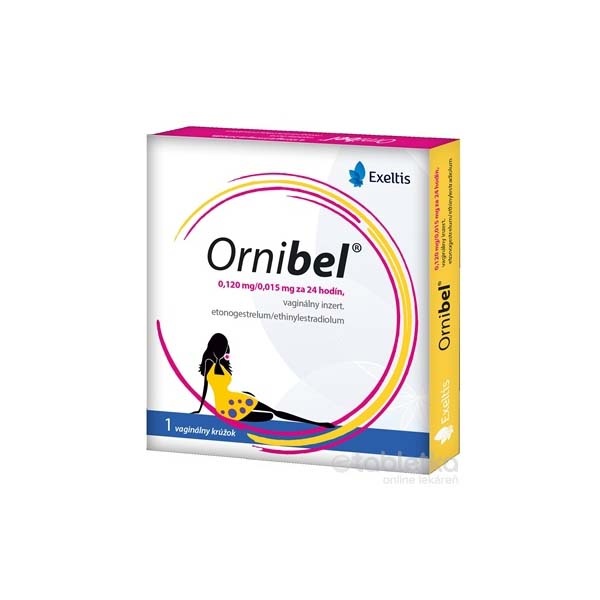
ОРНИБЕЛ 0,120 МГ/0,015 МГ каждые 24 часа вагинальная система доставки


Инструкция по применению ОРНИБЕЛ 0,120 МГ/0,015 МГ каждые 24 часа вагинальная система доставки
Введение
Инструкция: информация для пользователя
Орнибель 0,120 мг/0,015 мг каждые 24 часа, вагинальная система с контролируемым высвобождением ЭФГ
(Этоногестрел/Этинилэстрадиол)
Важные вещи, которые вы должны знать об гормональных комбинированных контрацептивах (ГКК):
- Это один из наиболее надежных обратимых методов контрацепции, если они используются правильно.
- Немного увеличивают риск образования кровяного сгустка в венах и артериях, особенно в первый год или когда возобновляется использование гормонального комбинированного контрацептива после перерыва 4 недели или более.
- Будьте бдительны и проконсультируйтесь с вашим врачом, если вы считаете, что можете иметь симптомы кровяного сгустка (см. раздел 2 «Кровяные сгустки»).
Прочитайте весь инструктаж внимательно перед началом использования Орнибеля, поскольку он содержит важную информацию для вас.
- Сохраните этот инструктаж, поскольку вам может потребоваться снова прочитать его.
- Если у вас есть какие-либо вопросы, проконсультируйтесь с вашим врачом или фармацевтом.
- Это лекарство было назначено только вам и не должно быть передано другим людям, поскольку оно может нанести им вред.
- Если вы испытываете побочные эффекты, проконсультируйтесь с вашим врачом или фармацевтом, даже если это побочные эффекты, которые не указаны в этом инструктаже. См. раздел 4.
Содержание инструкции
- Что такое Орнибель и для чего он используется
- Что вам нужно знать перед началом использования Орнибеля
2.1 Когда не следует использовать Орнибель
2.2 Предостережения и меры предосторожности
Кровяные сгустки
Рак
2.3 Дети и подростки
2.4 Другие лекарства и Орнибель
Лабораторные тесты
2.5 Беременность и лактация
2.6 Вождение и использование машин
- Как использовать Орнибель
3.1 Способ введения и удаления Орнибеля
3.2 Три недели внутри, одна неделя снаружи
3.3 Когда начинать с первого кольца
3.4 Что делать, если…
Ваше кольцо случайно вышло из влагалища
Ваше кольцо было временно вне влагалища
Кольцо открылось
Было введено более одного кольца
Если вы забыли ввести новое кольцо после перерыва без кольца
Если вы забыли удалить кольцо
Если у вас не начался менструальный цикл или регула
Если у вас произошло неожиданное кровотечение
Если вы хотите изменить день начала менструального цикла или регулы
Если вы хотите отложить менструальный цикл или регulu
3.5 Если вы хотите прекратить использование Орнибеля.
- Возможные побочные эффекты
- Хранение Орнибеля
- Содержание упаковки и дополнительная информация
Состав Орнибеля
Внешний вид Орнибеля и содержание упаковки
Владелец лицензии на коммерциализацию и ответственный за производство
1. Что такое Орнибель и для чего он используется
Орнибель - это вагинальное контрацептивное кольцо, используемое для предотвращения беременности. Каждое кольцо содержит небольшое количество двух женских половых гормонов, этоногестрел и этинилэстрадиол. Кольцо медленно высвобождает эти гормоны в кровоток. Учитывая небольшое количество высвобожденных гормонов, Орнибель является гормональным контрацептивом с низкой дозой.
Поскольку Орнибель высвобождает два разных типа гормонов, это комбинированный гормональный контрацептив
Орнибель действует как комбинированная противозачаточная таблетка ( «таблетка»), но вместо приема таблетки каждый день, кольцо используется в течение 3 последовательных недель. Орнибель высвобождает два женских половых гормона, которые предотвращают высвобождение яйцеклетки из яичников. Если не высвобождается никакая яйцеклетка, вы не можете забеременеть
2. Что вам нужно знать перед началом использования Орнибела
Общие соображения
Прежде чем начать использовать Орнибел, вы должны прочитать информацию о тромбах крови в разделе 2. Особенно важно, чтобы вы прочитали симптомы тромба крови (см. раздел 2 «Тромбы крови»).
В этом листке описаны различные ситуации, в которых вам необходимо прекратить использование Орнибела или когда Орнибел может быть менее надежным. В этих ситуациях вам не следует иметь половые контакты или вам необходимо принять дополнительные не гормональные меры контрацепции, такие как презерватив или другой барьерный метод. Неиспользуйте метод ритма или метод температуры. Эти методы могут быть ненадежными, поскольку Орнибел изменяет ежемесячные изменения температуры тела и шейной слизи.
Орнибел, как и другие гормональные контрацептивы, не защищает от заражения ВИЧ (СПИД) или любой другой болезни, передающейся половым путем.
2.1 Когда не следует использовать Орнибел
Не следует использовать Орнибел, если у вас есть какие-либо из следующих состояний. Сообщите вашему врачу, если у вас есть какие-либо из следующих состояний. Ваш врач обсудит с вами, какой другой метод контрацепции будет более подходящим.
- Если у вас есть (или было ранее) тромб крови в вене ноги (глубокий венозный тромбоз, ДВТ), в легких (пульмонная эмболия, ПЭ) или в других органах.
- Если вы знаете, что страдаете заболеванием, которое влияет на свертываемость крови: например, дефицит белка С, дефицит белка С, дефицит антитромбина III, фактор V Лейдена или антифосфолипидные антитела.
- Если вам необходимо хирургическое вмешательство или если вы проводите много времени без движения (см. раздел «Тромбы крови»).
- Если вы когда-либо имели инфаркт миокарда или инсульт.
- Если у вас есть (или было ранее) стенокардия (заболевание, которое вызывает сильную боль в груди и может быть первым признаком инфаркта миокарда) или транзиторная ишемическая атака (ТИА, временные симптомы инсульта).
- Если у вас есть какие-либо из следующих заболеваний, которые могут увеличить ваш риск образования тромба в артериях:
- Сахарный диабет с поражением кровеносных сосудов.
- Очень высокое кровяное давление.
- Очень высокие уровни жира в крови (холестерин или триглицериды).
- Состояние, называемое гипергомоцистеинемией.
- Если у вас есть (или было ранее) тип мигрени, называемый «мигренью с аурой».
- Если у вас есть или было воспаление поджелудочной железы (панкреатит), связанное с высокими уровнями жира в крови.
- Если у вас есть или было тяжелое заболевание печени и ваша печень еще не функционирует нормально.
- Если у вас есть или было доброкачественная или злокачественная опухоль печени.
- Если у вас есть, было или может быть рак молочной железы или гениталий.
- Если у вас есть вагинальное кровотечение неизвестной причины.
- Если вы аллергичны к этинилэстрадиолу или этоногестрелу или к любому другому компоненту этого препарата (включая раздел 6).
Если какая-либо из этих обстоятельств возникает впервые во время использования Орнибела, снимите кольцо немедленно и проконсультируйтесь с вашим врачом. Тем временем используйте не гормональные меры контрацепции.
Не используйте Орнибел, если у вас есть гепатит С или если вы принимаете лекарства, содержащие омбитасвир/паритапревир/ритонавир и дасабувир или глекапревир/пибрентасвир или софосбувир/велпатасвир/воксилапревир (см. также раздел 2.4 «Использование Орнибела с другими лекарствами»)
2.2 Предостережения и меры предосторожности
Когда вам необходимо проконсультироваться с вашим врачом?
Обратитесь за медицинской помощью немедленно
- Если вы заметили возможные признаки тромба крови, которые могут указывать на то, что вы страдаете тромбом крови в ноге (т.е. глубокий венозный тромбоз), тромбом крови в легких (т.е. пульмонная эмболия), инфарктом миокарда или инсультом (см. раздел «Тромбы крови» ниже).
Для получения описания симптомов этих тяжелых побочных эффектов см. «Как распознать тромб крови»
Сообщите вашему врачу, если вы страдаете каким-либо из следующих состояний.
Если состояние развивается или ухудшается во время использования Орнибела, вам также необходимо сообщить об этом вашему врачу.
- Если у вашего близкого родственника есть или было рак молочной железы.
- Если вы страдаете эпилепсией (см. раздел 2.4. «Другие лекарства и Орнибел»).
- Если у вас есть заболевание печени (например, желтуха) или желчного пузыря (например, камни в желчном пузыре).
- Если у вас есть болезнь Крона или язвенный колит (хроническое воспалительное заболевание кишечника).
- Если у вас есть системная красная волчанка (СКВ, заболевание, которое влияет на вашу естественную систему защиты).
- Если у вас есть гемолитико-уремический синдром (ГУС, заболевание, которое влияет на свертываемость крови и вызывает почечную недостаточность).
- Если у вас есть серповидно-клеточная анемия (наследственное заболевание красных кровяных клеток).
- Если у вас есть высокие уровни жира в крови (гипертриглицеридемия) или известные семейные анамнезы этого состояния. Гипертриглицеридемия связана с повышенным риском панкреатита (воспаления поджелудочной железы).
- Если вам необходимо хирургическое вмешательство или если вы проводите много времени без движения (см. раздел 2 «Тромбы крови»).
- Если вы недавно родили, вы имеете повышенный риск тромба крови. Вы должны спросить вашего врача, когда вы можете начать принимать Орнибел после родов.
- Если у вас есть воспаление вен, расположенных под кожей (поверхностный тромбофлебит).
- Если у вас есть варикоз.
- Если вы страдаете заболеванием, которое впервые появилось или ухудшилось во время беременности или предыдущего использования гормональных препаратов (например, потеря слуха, порфирия [заболевание крови], герпес беременности [кожная сыпь с пузырьками во время беременности] или хорея Сиденгама [нервное заболевание, характеризующееся непроизвольными движениями]).
- Если у вас есть или было хлоазма (желтовато-коричневые пятна на коже, называемые «пятнами беременности», особенно на лице); если это так, избегайте чрезмерного воздействия солнца или ультрафиолетового излучения.
- Если у вас есть расстройства, которые затрудняют использование Орнибела, например, если вы страдаете запором, пролапсом шейки матки или испытываете боль во время половых контактов.
- Если у вас есть срочное, частое, болезненное или жгучее мочеиспускание, и вы не можете определить положение кольца во влагалище. Эти симптомы могут указывать на то, что Орнибел был случайно введен в мочевой пузырь.
- Если вы испытываете симптомы ангioneуротического отека, такие как отек лица, языка и/или горла и/или затруднение глотания или крапивница с возможным затруднением дыхания, свяжитесь с врачом немедленно. Продукты, содержащие эстроген, могут вызывать или ухудшать симптомы наследственного и приобретенного ангioneуротического отека.
ТРОМБЫ КРОВИ
Использование гормонального контрацептива, такого как Орнибел, увеличивает ваш риск тромба крови по сравнению с отсутствием его использования. В редких случаях тромб крови может блокировать кровеносные сосуды и вызывать серьезные проблемы.
Тромбы крови могут образовываться:
- В венах (что называется «венозный тромбоз», «венозный тромбоэмболизм» или ВТЭ).
- В артериях (что называется «артериальный тромбоз», «артериальный тромбоэмболизм» или АТЭ).
Восстановление после тромбов крови не всегда полное. В редких случаях могут быть серьезные долгосрочные последствия или, очень редко, могут быть смертельными.
Важно помнить, что общий риск тромба крови, вызванного Орнибелом, небольшой.
КАК РАСПОЗНАТЬ ТРОМБ КРОВИ
Обратитесь за медицинской помощью немедленно, если вы заметили какие-либо из следующих признаков или симптомов.
Вы испытываете какие-либо из этих признаков? | Что вы можете испытывать? |
| Глубокий венозный тромбоз |
Если вы не уверены, проконсультируйтесь с врачом, поскольку некоторые из этих симптомов, такие как кашель или одышка, могут быть ошибочно приняты за более легкое состояние, такое как респираторная инфекция (например, «простуда»). | Пульмонная эмболия |
Симптомы, которые возникают чаще в одном глазу:
| Тромбоз сетчатки (тромб крови в глазу). |
| Инфаркт миокарда. |
Иногда симптомы инсульта могут быть кратковременными, с почти полным восстановлением, но все равно необходимо обратиться за медицинской помощью немедленно, поскольку вы можете быть подвержены риску повторного инсульта. | Инсульт. |
| Тромбы крови, блокирующие другие кровеносные сосуды. |
ТРОМБЫ КРОВИ В ВЕНЕ
Что может произойти, если образуется тромб крови в вене?
- Использование гормональных контрацептивов, таких как Орнибел, связано с повышенным риском тромбов крови в венах (венозный тромбоз). Однако эти побочные эффекты редки. Они возникают чаще в первый год использования гормонального контрацептива.
- Если тромб крови образуется в вене ноги или стопы, это может вызвать глубокий венозный тромбоз (ГВТ).
- Если тромб крови перемещается из ноги и застревает в легких, это может вызвать пульмонную эмболию.
- В очень редких случаях может образоваться тромб в вене другого органа, такого как глаз (тромбоз сетчатки).
Когда повышается риск тромба крови в вене?
Риск тромба крови в вене выше в течение первого года, когда вы впервые начинаете использовать гормональный контрацептив. Риск может быть выше также, если вы снова начинаете использовать гормональный контрацептив (тот же препарат или другой) после перерыва в 4 недели или более.
После первого года риск снижается, но всегда остается немного выше, чем если бы вы не использовали гормональный контрацептив.
Когда вы прекращаете использовать Орнибел, ваш риск тромба крови возвращается к норме в течение нескольких недель.
Каков риск тромба крови?
Риск зависит от вашего естественного риска ВТЭ и от типа гормонального контрацептива, который вы используете.
Общий риск тромба крови в ноге или легких (ГВТ или ПЭ) с Орнибелом небольшой.
- Из каждых 10 000 женщин, которые не используют гормональный контрацептив и не беременны, около 2 женщин могут иметь тромб крови в течение года.
- Из каждых 10 000 женщин, которые используют гормональный контрацептив, содержащий левоноргестрел, норэтистерон или норегестимат, около 5-7 женщин могут иметь тромб крови в течение года.
- Из каждых 10 000 женщин, которые используют гормональный контрацептив, содержащий норелгестромин или этоногестрел, такие как Орнибел, около 6-12 женщин могут иметь тромб крови в течение года.
- Риск тромба крови зависит от вашей личной истории (см. «Факторы, повышающие ваш риск тромба крови» ниже).
Риск тромба крови в течение года | |
Женщины, которые не используютгормональный контрацептив и не беременны | Около 2 из каждых 10 000 женщин |
Женщины, которые используют гормональный контрацептив, содержащий левоноргестрел, норэтистерон или норегестимат | Около 5-7 из каждых 10 000 женщин |
Женщины, которые используют Орнибел | Около 6-12 из каждых 10 000 женщин |
Факторы, повышающие ваш риск тромба крови в вене
Риск тромба крови с Орнибелом небольшой, но некоторые состояния повышают риск. Ваш риск выше:
- Если у вас есть избыточный вес (индекс массы тела или ИМТ выше 30 кг/м2).
- Если у вашего близкого родственника был тромб крови в ноге, легких или другом органе в молодом возрасте (около 50 лет). В этом случае вы можете иметь наследственное заболевание свертываемости крови.
- Если вам необходимо хирургическое вмешательство или если вы проводите много времени без движения из-за травмы или заболевания или если у вас есть гипс на ноге. Возможно, вам необходимо будет прекратить использование Орнибела за несколько недель до операции или во время снижения подвижности. Если вам необходимо прекратить использование Орнибела, спросите вашего врача, когда вы можете снова начать использовать его.
- С возрастом (особенно после 35 лет).
- Если вы недавно родили.
Риск тромба крови увеличивается, если у вас есть несколько состояний.
Авиаперелеты (более 4 часов) могут временно увеличить риск тромба крови, особенно если у вас есть другие факторы риска, перечисленные выше.
Важно сообщить вашему врачу, если вы страдаете каким-либо из вышеуказанных состояний, даже если вы не уверены. Ваш врач может решить, что необходимо прекратить использование Орнибела.
Если какое-либо из вышеуказанных состояний меняется во время использования Орнибела, например, если ваш близкий родственник испытал тромб без известной причины или если вы значительно набрали вес, сообщите об этом вашему врачу.
ТРОМБЫ КРОВИ В АРТЕРИИ
Что может произойти, если образуется тромб крови в артерии?
Как и тромб крови в вене, тромб в артерии может вызвать серьезные проблемы. Например, он может вызвать инфаркт миокарда или инсульт.
Факторы, повышающие ваш риск тромба крови в артерии
Важно отметить, что риск инфаркта миокарда или инсульта, вызванного Орнибелом, очень небольшой, но он может увеличиться:
- С возрастом (после 35 лет).
- Если вы курите.Когда вы используете гормональный контрацептив, такой как Орнибел, вам рекомендуется бросить курить. Если вы не можете бросить курить и вам более 35 лет, ваш врач может порекомендовать использовать другой тип контрацептива.
- Если у вас есть избыточный вес.
- Если у вас есть высокое кровяное давление.
- Если у вашего близкого родственника был инфаркт миокарда или инсульт в молодом возрасте (около 50 лет). В этом случае вы также можете иметь повышенный риск инфаркта миокарда или инсульта.
- Если у вас или у вашего близкого родственника высокий уровень жира в крови (холестерин или триглицериды).
- Если у вас есть мигрень, особенно мигрень с аурой.
- Если у вас есть проблема с сердцем (нарушение функции клапанов, нарушение сердечного ритма, называемое фибрилляцией предсердий).
- Если у вас есть диабет.
Если у вас есть одно или несколько из этих состояний или если одно из них особенно тяжелое, риск тромба крови может быть еще выше.
Если какое-либо из вышеуказанных состояний меняется во время использования Орнибела, например, если вы начинаете курить, ваш близкий родственник испытал тромб без известной причины или если вы значительно набрали вес, сообщите об этом вашему врачу.
РАК
Следующая информация получена из исследований гормональных контрацептивов и может быть применима к Орнибелу. Нет информации об введении гормональных контрацептивов через vagina (как Орнибел).
Были зарегистрированы случаи рака молочной железы с немного более высокой частотой у женщин, использующих гормональные контрацептивы, но неизвестно, является ли это вызвано лечением. Например, возможно, что больше опухолей обнаруживается у женщин, использующих гормональные контрацептивы, потому что они более часто посещают врача. Это увеличение частоты снижается постепенно после прекращения лечения.
Важно регулярно осматривать ваши груди и сообщать вашему врачу, если вы заметите какие-либо уплотнения. Сообщите вашему врачу, если у вашего близкого родственника есть или было рак молочной железы (см. раздел 2.2 «Предостережения и меры предосторожности»).
Редко сообщались случаи доброкачественных или злокачественных опухолей печени у женщин, использующих гормональные контрацептивы. Свяжитесь с вашим врачом, если у вас есть сильная и необычная боль в животе.
У пользователей гормональных контрацептивов было обнаружено, что рак эндометрия (ткань, выстилающая матку) или яичников возникает реже. Это также может быть справедливо для Орнибела, но это не подтверждено.
ПСИХИАТРИЧЕСКИЕ РАССТРОЙСТВА:
Некоторые женщины, использующие гормональные контрацептивы, такие как Орнибел, сообщали о депрессии или пониженном настроении. Депрессия может быть тяжелой и иногда может вызывать суицидальные мысли. Если вы испытываете изменения настроения и депрессивные симптомы, свяжитесь с вашим врачом для получения дополнительных медицинских рекомендаций как можно скорее.
2.3 Дети и подростки
Безопасность и эффективность Орнибела у подростков младше 18 лет не установлены.
2.4 Другие лекарства и Орнибел
Всегда сообщайте своему врачу о лекарствах или лекарственных растениях, которые вы принимаете. Сообщите также любому врачу или стоматологу (или фармацевту), который назначает вам другое лекарство, что вы используете Орнибел. Они смогут сообщить вам, нужно ли вам принимать какие-либо дополнительные меры контрацепции (например, использовать презервативы) и если да, то на какой срок, или же нужно ли изменить использование другого лекарства.
Некоторые лекарства
- могут влиять на уровень Орнибела в крови
- могут сделать его менее эффективным для предотвращения беременности
- могут вызывать непредвиденные кровотечения.
К ним относятся лекарства, используемые для лечения:
- эпилепсии (например, примидона, фенитоина, барбитуратов, карбамазепина, окскарбазепина, топирамата, фелбамата);
- туберкулеза (например, рифампицина);
- инфекции ВИЧ (например, ритонавира, нельфинавира, невирапина, эфавиренза);
- инфекции вируса гепатита С (например, босепревира, телапревира);
- других инфекционных заболеваний (например, грисеофульвина);
- высокого давления в кровеносных сосудах легких (бозентана);
- депрессивных состояний (лекарственного растения Йохимбе).
Если вы принимаете лекарства или лекарственные растения, которые могут сделать Орнибел менее эффективным, вы должны использовать также метод контрацепции барьерного типа (например, презерватив). Поскольку эффект другого лекарства на Орнибел может длиться до 28 дней после отмены лекарства, в течение этого времени необходимо использовать дополнительный метод контрацепции барьерного типа. Примечание: Не используйте Орнибел вместе с диафрагмой, цервикальным колпачком или женским презервативом.
Орнибел может влиять на эффект других лекарств, например:
- лекарств, содержащих циклоспорин
- антиэпилептического ламотриджина (это может привести к увеличению частоты судорог)
Не используйте Орнибел, если у вас гепатит С и вы принимаете лекарства, содержащие омбитасвир/паритапревир/ритонавир и дасабувир или глекапревир/пибрентасвир или софосбувир/велпатасвир/воксилапревир, поскольку эти лекарства могут вызывать увеличение показателей функции печени в крови (увеличение печеночной ферменты ALT).
Ваш врач назначит вам другой тип контрацепции перед началом лечения этими лекарствами.
Орнибел можно возобновить примерно через 2 недели после завершения этого лечения. См. раздел 2.1 «Когда не следует использовать Орнибел».
Проконсультируйтесь с вашим врачом или фармацевтом перед приемом любого лекарства.
Тампоны можно использовать во время использования Орнибела. Сначала вставьте Орнибел, затем тампон. Будьте особенно осторожны при удалении тампона, чтобы кольцо не было случайно выталкнуто. Если кольцо было выталкнуто, просто промойте его холодной или теплой водой и вставьте обратно немедленно.
Кольцо можно открыть, если вы также используете вагинальный продукт, такой как смазка или лечение инфекции (см. раздел 3.4 «Что делать, если...кольцо открывается»)
Использование спермицидов или продуктов для лечения вагинальных грибков не снижает эффективность контрацепции Орнибела.
Лабораторные исследования
Если вам назначены анализы крови или мочи, сообщите вашему врачу, что вы используете Орнибел, поскольку это может повлиять на результат некоторых анализов.
2.5 Беременность и лактация
Орнибел не должен использоваться беременными женщинами или женщинами, которые подозревают, что могут быть беременными. Если вы забеременеете во время использования Орнибела, вам необходимо удалить кольцо и проконсультироваться с вашим врачом.
Если вы хотите прекратить использование Орнибела, потому что хотите забеременеть, см. раздел 3.5 «Если вы хотите прекратить использование Орнибела».
Обычно не рекомендуется использовать Орнибел во время грудного вскармливания. Если вы хотите использовать Орнибел во время грудного вскармливания, проконсультируйтесь с вашим врачом.
2.6 Вождение и использование машин
Орнибел вряд ли повлияет на вашу способность управлять транспортными средствами или использовать машины
3. Как использовать Орнибель
Вы можете самостоятельно поставить и удалить Орнибель. Ваш врач укажет, когда начать использовать его впервые. Вагинальное кольцо должно быть введено в день менструального цикла (см. раздел 3.3 «Когда начинать с первого кольца») и оставаться во влагалище в течение 3 недель подряд. Регулярно проверяйте, осталось ли кольцо во влагалище (например, перед и после полового акта), чтобы убедиться, что вы защищены от беременности. После третьей недели удалите Орнибель и сделайте перерыв на одну неделю. Обычно у вас будет менструация или регла во время этого перерыва без кольца.
Пока вы используете Орнибель, не должны использовать некоторые женские барьерные методы контрацепции, такие как вагинальный диафрагма, цервикальная шапочка или женский презерватив. Эти барьерные методы контрацепции не должны использоваться в качестве дополнительного метода контрацепции, поскольку Орнибель может повлиять на правильное положение диафрагмы, цервикальной шапочки или женского презерватива. Однако вы можете использовать мужской презерватив в качестве дополнительного барьерного метода контрацепции.
3.1 Способ надевания и снимания Орнибеля
- Перед надеванием кольца проверьте, что оно не просрочено (см. раздел 5 «Хранение Орнибеля»).
- Мойте руки перед надеванием или сниманием кольца.
- Выберите наиболее удобное положение для введения кольца, например, стоя с одной ногой, поднятой вверх, в полуприседании или лежа.
- Удалите Орнибель из упаковки. Сохраните упаковку для дальнейшего использования.
- Держите кольцо между указательным и большим пальцами, нажмите на противоположные стороны и введите кольцо во влагалище (см. рисунки 1-4).
Когда Орнибель находится на месте, вы не должны ничего чувствовать. Если вы чувствуете себя некомфортно, осторожно нажмите Орнибель внутрь влагалища. Точное положение кольца внутри влагалища не имеет значения.
- Через 3 недели удалите Орнибель из влагалища. Вы можете сделать это, зацепив кольцо указательным пальцем или держа его между пальцами и потянув наружу (см. рисунок 5). Если вы не можете удалить кольцо, несмотря на то, что нашли его, обратитесь к врачу.
- Удалите использованное кольцо вместе с обычными бытовыми отходами, предпочтительно в упаковке. Не выбрасывайте Орнибель в туалет.

Рисунок 1
Удалите Орнибель из упаковки
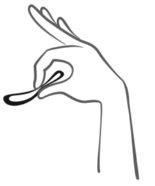
Рисунок 2
Нажмите на кольцо
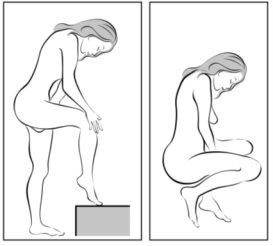
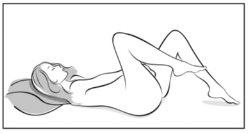
Рисунок 3
Выберите удобное положение для надевания кольца
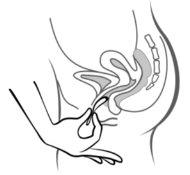
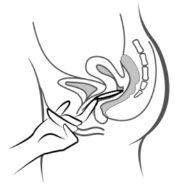
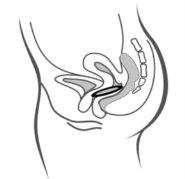
Рисунок 4А Рисунок 4Б Рисунок 4В
Наденьте кольцо во влагалище одной рукой (Рисунок 4А), если необходимо, разделите губы влагалища другой рукой. Осторожно нажмите кольцо внутрь влагалища, пока не почувствуете себя комфортно (Рисунок 4Б). Оставьте кольцо во влагалище в течение 3 недель (Рисунок 4В).
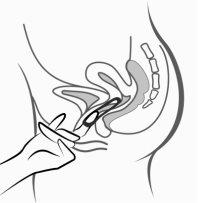
Рисунок 5:
Орнибель можно удалить, зацепив кольцо указательным пальцем или держа его между пальцами и потянув наружу.
3.2 Три недели внутри, одна неделя снаружи
- Вагинальное кольцо должно оставаться во влагалище с дня его введения в течение 3 недель подряд, без перерыва.
- Через 3 недели удалите кольцо в тот же день недели, что и ввели его, и примерно в то же время. Например, если вы ввели его в среду примерно в 22:00, то должны удалить его через 3 недели, в среду, примерно в 22:00.
- После удаления кольца не используйте его в течение одной недели. В течение этой недели должно произойти вагинальное кровотечение. Обычно оно начинается через 2-3 дня после удаления Орнибеля.
- Наденьте новое кольцо точно через неделю после перерыва (снова в тот же день недели и примерно в то же время), даже если еще не прекратилось кровотечение.
Если вы наденете новое кольцо более чем через 3 часа после запланированного времени, эффективность контрацепции может уменьшиться. Следуйте инструкциям раздела 3.4 «Что делать, если забыли надеть новое кольцо после перерыва без кольца».
Если вы используете Орнибель, как описано выше, ваше кровотечение будет происходить примерно в те же дни каждого месяца.
3.3 Когда начинать с первого кольца
- Если вы не использовали гормональную контрацепцию в предыдущем месяце
Наденьте Орнибель в первый день вашего естественного цикла (т.е. в первый день менструации). Орнибель начинает действовать сразу. Вам не нужно принимать другие меры контрацепции.
Также можно начать использовать Орнибель между 2-м и 5-м днем цикла, но если у вас были половые контакты в течение первых 7 дней использования Орнибеля, убедитесь, что используете дополнительный метод контрацепции (презерватив). Следуйте этой рекомендации только при первом использовании Орнибеля.
- Если вы использовали комбинированные гормональные таблетки в предыдущем месяце
Начните использовать Орнибель не позднее дня после перерыва в использовании текущих таблеток. Если упаковка ваших таблеток также содержит неактивные таблетки, начните использовать Орнибель не позднее дня после последней неактивной таблетки. Если вы не уверены, какая таблетка является последней, проконсультируйтесь с врачом или фармацевтом. Никогда не продлевайте дни перерыва в использовании текущих таблеток больше, чем рекомендовано.
Если вы принимали текущие таблетки непрерывно и правильно и уверены, что не беременны, также можете прекратить принимать таблетки в любой день цикла и начать использовать Орнибель сразу.
- Если вы использовали трансдермальный пластырь в предыдущем месяце
Начните использовать Орнибель не позднее дня после перерыва без пластыря. Не продлевайте дни перерыва без пластыря больше, чем рекомендовано.
Если вы использовали пластырь непрерывно и правильно и уверены, что не беременны, также можете снять пластырь в любой день и начать использовать Орнибель сразу.
- Если вы использовали таблетки только с прогестагеном в предыдущем месяце
Вы можете прекратить принимать таблетки с прогестагеном в любой день и начать использовать Орнибель на следующий день в то же время. Но убедитесь, что также используете дополнительный метод контрацепции (презерватив) в течение первых 7 дней использования кольца.
- Если вы использовали инъекции, имплант или систему внутриматочной доставки гормонов (прогестаген) в предыдущем месяце
Начните использовать Орнибель в момент, когда должны были получить следующую инъекцию или в день удаления импланта или системы. Но убедитесь, что используете дополнительный метод контрацепции (презерватив) в течение первых 7 дней использования кольца.
- После родов
Если вы только что родили, ваш врач может посоветовать вам подождать до появления первой нормальной менструации, прежде чем начать использовать Орнибель. Иногда возможно начать использовать раньше, ваш врач посоветует, как это сделать. Если вы кормите грудью и хотите использовать Орнибель, проконсультируйтесь с врачом сначала.
- После аборта
Проконсультируйтесь с врачом.
3.4 Что делать, если...
Ваше кольцо случайно выпало из влагалища
Орнибель может случайно выпасть из влагалища, например, если его не ввели правильно, при удалении тампона, во время полового акта, если у вас запор или если у вас проlapс матки (опущение матки). Поэтому регулярно проверяйте, осталось ли кольцо во влагалище (например, перед и после полового акта).
Ваше кольцо было вне влагалища временно
Орнибель все еще может защитить вас от беременности, но это зависит от того, сколько времени оно было вне влагалища.
Если кольцо было вне влагалища:
- Менее 3 часов, оно все еще защитит вас от беременности. Вымойте кольцо холодной или теплой водой (не используйте горячую воду) и введите его обратно во влагалище как можно скорее, но только если кольцо было вне влагалища менее 3 часов.
- Более 3 часов в 1-й или 2-й неделе, оно может не защитить вас от беременности. Вымойте кольцо холодной или теплой водой (не используйте горячую воду) и введите его обратно во влагалище как можно скорее. Используйте мужской презерватив, если имеете половые контакты в течение этих 7 дней. Если у вас были половые контакты в течение 7 дней перед этим, существует возможность того, что вы могли забеременеть. В этом случае проконсультируйтесь с врачом.
- Более 3 часов в 3-й неделе, оно может не защитить вас от беременности. Удалите кольцо и выберите одну из двух следующих опций:
- Наденьте новое кольцо сразу.
Надев новое кольцо, вы начнете новый 3-недельный цикл использования. Возможно, у вас не будет менструации. Однако может произойти межменструальное кровотечение или пятна во время этого цикла.
- Не надевайте новое кольцо. Подождите межменструальное кровотечение и наденьте новое кольцо не позднее 7 дней после удаления или выпадения предыдущего кольца.
Выберите эту опцию только если вы использовали Орнибель непрерывно в течение 7 дней перед этим.
Если Орнибель был вне влагалища неизвестное время, оно может не защитить вас от беременности. Вам необходимо сделать тест на беременность и проконсультироваться с врачом, прежде чем ввести новое кольцо.
Кольцо разорвалось
Орнибель может разорваться. Были зарегистрированы случаи вагинальной травмы, связанные с разрывом кольца. Если вы заметили, что Орнибель разорвался, удалите кольцо и наденьте новое как можно скорее. Примите дополнительные меры контрацепции (например, мужской презерватив) в течение 7 дней. Если у вас были половые контакты до того, как вы заметили, что кольцо разорвалось, проконсультируйтесь с врачом.
Вы надели более одного кольца
Не было зарегистрировано серьезных повреждений из-за передозировки гормонов Орнибеля. Если вы случайно надели более одного кольца, вы можете чувствовать себя плохо (тошнота), рвать или иметь вагинальное кровотечение. Удалите лишнее кольцо и обратитесь к врачу, если эти симптомы не исчезнут. Также можно позвонить в Центр токсикологической информации, телефон: 91 562 04 20, указав препарат и количество, использованное.
Если вы забыли надеть новое кольцо после перерыва без кольца
Ваш перерыв без кольцадлился более 7 дней. Наденьте новое кольцо во влагалище как можно скорее. Примите дополнительные меры контрацепции (например, мужской презерватив) если имеете половые контакты в течение следующих 7 дней. Если у вас были половые контакты во время этого перерыва без кольца, существует возможность того, что вы могли забеременеть. В этом случае сообщите об этом врачу немедленно. Чем дольше перерыв без кольца, тем выше риск беременности.
Если вы забыли удалить кольцо
- Если кольцо было во влагалище между 3 и 4 неделями, оно все еще защитит вас от беременности. Подождите неделю без кольца и затем наденьте новое.
- Если кольцо было во влагалище более 4 недель, существует возможность беременности. Обратитесь к врачу, прежде чем начать использовать новое кольцо.
Если менструация не началась
- Вы использовали Орнибель согласно инструкциям.
Если менструация не началась, но вы использовали Орнибель согласно инструкциям и не принимали другие препараты, очень маловероятно, что вы беременны. Продолжайте использовать Орнибель в обычном режиме. Однако, если у вас две последовательные неявки, возможно, вы беременны, поэтому сообщите об этом врачу немедленно. Не надевайте следующее кольцо, пока врач не подтвердит, что вы не беременны.
- Если вы отклонились от рекомендованного режима использования Орнибеля.
Если менструация не началась во время перерыва без кольца и вы отклонились от рекомендованного режима, существует возможность того, что вы могли забеременеть, поэтому обратитесь к врачу, прежде чем надеть новое кольцо.
Если у вас внезапное кровотечение
У некоторых женщин во время использования Орнибеля может возникнуть внезапное вагинальное кровотечение между менструациями. Вам может потребоваться гигиеническая защита. Тем не менее, продолжайте использовать кольцо в обычном режиме, не удаляя его. Если кровотечение продолжается, становится более интенсивным или начинается снова, проконсультируйтесь с врачом.
Если вы хотите изменить день начала менструации
Если вы используете Орнибель согласно инструкциям, менструация начнется во время перерыва без кольца. Если вы хотите изменить день начала, вам необходимо сократить (никогда не продлевать!) перерыв без кольца.
Например, если менструация обычно начинается в пятницу, вы можете изменить ее на вторник, т.е. на 3 дня раньше, начиная с следующего месяца. Просто наденьте следующее кольцо на 3 дня раньше обычного.
Если перерыв очень короткий (например, 3 дня или меньше), возможно, у вас не будет обычной менструации. У вас может быть межменструальное кровотечение или пятна во время использования следующего кольца.
Если вы не уверены, как это сделать, проконсультируйтесь с врачом.
Если вы хотите отложить менструацию
Хотя это не рекомендованный режим, вы можете отложить менструацию, надев новое кольцо сразу после удаления текущего, без перерыва между кольцами. Вы можете оставить новое кольцо во влагалище до 3 недель. Во время использования нового кольца у вас может быть межменструальное кровотечение или нерегулярное кровотечение. Когда вы захотите, чтобы началась менструация, просто удалите кольцо. Подождите обычный перерыв без кольца и затем наденьте новое.
Вы можете проконсультироваться с врачом, прежде чем решить отложить менструацию.
3.5 Если вы хотите прекратить использовать Орнибель
Вы можете прекратить использовать Орнибель в любое время. Если вы не хотите забеременеть, проконсультируйтесь с врачом о других методах контрацепции.
Если вы прекратите использовать Орнибель, потому что хотите забеременеть, рекомендуется подождать до появления первой естественной менструации, прежде чем попытаться забеременеть. Это поможет вам рассчитать дату родов.
4. Возможные побочные эффекты
Как и все лекарства, это лекарство может вызывать побочные эффекты, хотя не все люди их испытывают. Если вы испытываете любой побочный эффект, особенно если он тяжелый и постоянный, или если у вас есть какие-либо изменения в здоровье, которые, по вашему мнению, могут быть связаны с Орнибелем, проконсультируйтесь с вашим врачом.
Все женщины, принимающие комбинированные гормональные контрацептивы, имеют более высокий риск образования тромбов в венах (тромбоэмболия вен) или тромбов в артериях (тромбоэмболия артерий). Для получения более подробной информации о различных рисках, связанных с приемом комбинированных гормональных контрацептивов, см. раздел 2 «Что вам нужно знать перед началом использования Орнибеля».
Свяжитесь с врачом немедленно, если вы испытываете любой из следующих симптомов ангиеодемы: отек лица, языка и/или горла и/или трудности с глотанием или крапивница с возможными трудностями с дыханием (см. также раздел «Предостережения и меры предосторожности»).
Пользователи кольца, содержащего Этоногестрел/Этинилэстрадиол, сообщили о следующих побочных эффектах:
Частые:могут повлиять до 1 из 10 женщин.
- боль в животе, недомогание (тошнота)
- инфекция влагалища, вызванная дрожжами (podobная кандидозу рта), неприятные ощущения во влагалище, зуд гениталий, выделения из влагалища
- головная боль или мигрень, депрессивное настроение, снижение либидо
- боль в груди, боль в тазу, болезненные менструации
- акне
- прибавка в весе
- выталкивание кольца
Редкие:могут повлиять до 1 из 100 женщин.
- нарушения зрения, головокружение
- вздутие живота, рвота, диарея или запор
- чувство усталости, раздражения или раздражительности, изменения настроения, изменения в состоянии духа
- задержка жидкости в организме (отек)
- инфекция мочи или мочевого пузыря
- трудности, боль при мочеиспускании; частое мочеиспускание
- проблемы в сексуальных отношениях, такие как боль, кровотечение или ощущение кольца партнером
- повышение артериального давления
- повышение аппетита
- боль в спине, судороги в мышцах, боль в ногах или руках
- снижение чувствительности кожи
- напряжение или боль в груди или увеличение размера; фиброцистическая болезнь груди (кисты в груди, которые могут увеличиваться или болеть)
- воспаление шейки матки, полипы, растущие на шейке матки, смещение ткани шейки матки наружу (эктропион)
- изменения менструального цикла (более интенсивные, длинные, нерегулярные или исчезающие), неприятные ощущения в тазу, предменструальный синдром, маточные спазмы
- инфекция влагалища (вызванная грибами или бактериями), жжение, запах, боль, неприятные ощущения или сухость влагалища или вульвы
- потеря волос, экзема, зуд, высыпания или приливы
- крапивница
Редкие:могут повлиять до 1 из 1000 женщин.
- вредные тромбы в вене или артерии, например:
- в ноге или ступне (т.е. ТВП)
- в легком (т.е. ЭП)
- инфаркт миокарда
- инсульт
- легкий инсульт или временные симптомы, подобные инсульту, называемые транзиторной ишемической атакой (ТИА)
- тромбы в печени, желудке/кишечнике, почках или глазах
Вероятность тромба может быть выше, если у вас есть другие состояния, которые увеличивают этот риск (см. раздел 2 для получения более подробной информации о состояниях, которые увеличивают риск тромбов и симптомах тромба).
- секреция молока из груди
Частота неизвестна(не может быть оценена из доступных данных).
- хлоазма (желто-коричневые пятна на коже, особенно на лице)
- неприятные ощущения в половом члене партнера (раздражение, высыпания, зуд)
- невозможность удалить кольцо без медицинской помощи (например, из-за его прикрепления к вагинальной стенке)
- вагинальная травма, связанная с разрывом кольца
Были зарегистрированы случаи рака груди и опухолей печени у женщин, принимающих комбинированные гормональные контрацептивы. Для получения более подробной информации см. раздел 2.2 Предостережения и меры предосторожности, Рак.
Орнибел может открыться. Для получения более подробной информации см. раздел 3.4 Что делать, если...кольцо открылось.
Сообщение о побочных эффектах:
Если вы испытываете любой побочный эффект, проконсультируйтесь с вашим врачом или фармацевтом, даже если это возможные побочные эффекты, которые не указаны в этом листке. Сообщая о побочных эффектах, вы можете способствовать предоставлению более подробной информации о безопасности этого лекарства.
Вы также можете сообщить о них напрямую через Испанскую систему фармаковигиланса лекарств для человека: https://www.notificaram.es
5. Хранение Орнибела
Храните это лекарство в недоступном для детей месте.
Если вы обнаружите, что ребенок подвергся воздействию гормонов Орнибела, проконсультируйтесь с вашим врачом.
Это лекарство не требует специальной температуры хранения.
Храните в оригинальной упаковке, чтобы защитить от света.
Орнибел должен быть введен не менее чем за месяц до даты истечения срока годности, указанной на коробке и на каждом блистере после CAD. Дата истечения срока годности - последний день месяца, указанного.
Не используйте Орнибел, если вы заметили изменения цвета кольца или любой видимый признак повреждения.
Это лекарство может представлять опасность для окружающей среды. После удаления Орнибел должен быть помещен обратно в блистер и закрыт. Закрытый блистер должен быть утилизирован с обычными бытовыми отходами или должен быть возвращен в аптеку для утилизации в соответствии с местными правилами.
Не выбрасывайте его в туалет. Как и с другими лекарствами, не выбрасывайте неиспользованные или просроченные кольца в канализацию или мусор.
Поместите упаковку и лекарства, которые вам больше не нужны, в пункт SIGRE аптеки. В случае сомнений спросите у вашего фармацевта, как утилизировать упаковку и лекарства, которые вам больше не нужны. Таким образом, вы поможете защитить окружающую среду.
6. Содержание упаковки и дополнительная информация
Состав Орнибела
- Активные вещества - этоногестрел и этинилэстрадиол.
Орнибел содержит 8,25 мг этоногестрела и 2,60 мг этинилэстрадиола. Кольцо выделяет этоногестрел и этинилэстрадиол в количестве 0,120 мг и 0,015 мг соответственно в течение 24 часов в течение 3 недель.
- Другие компоненты - сополимер ацетата винила и этилена 28% ацетата винила и полиуретан (тип пластика, который не растворяется в организме).
Внешний вид Орнибела и содержание упаковки
Вагинальная система выпуска.
Орнибел - гибкое, прозрачное, бесцветное или почти бесцветное кольцо, диаметром 54 мм и толщиной 4 мм.
Каждое кольцо упаковано в алюминиевый блистер. Блистер представлен в картонной коробке вместе с этим листком и стикерами для вашего календаря, которые помогут вам запомнить, когда вставить или удалить кольцо.
Каждая коробка содержит 1, 3 или 6 колец.
Возможно, не все размеры упаковок будут продаваться.
Владелец разрешения на продажу и производитель
Владелец разрешения на продажу:
Exeltis Healthcare, S.L.
Avda. De Miralcampo 7.
Полигон Индустриал Миралькампо.
19200 Асукека-де-Энарес. Гвадалахара.
Испания
Производитель:
Лаборатории Леон Фарма, S.A.
Пол. Инд. Наватехера.
Ла-Вальина с/н.
24193 Виллакильямбре, Леон.
Испания.
Это лекарство разрешено к продаже в государствах-членах Европейского экономического пространства под следующими названиями:
Дата последнего обновления этого листка:Ноябрь 2024
Подробная информация о этом лекарстве доступна на сайте Испанского агентства по лекарствам и медицинским продуктам (AEMPS) (http://www.aemps.gob.es/)

Сколько стоит ОРНИБЕЛ 0,120 МГ/0,015 МГ каждые 24 часа вагинальная система доставки в Испании в 2025 году?
Средняя цена на ОРНИБЕЛ 0,120 МГ/0,015 МГ каждые 24 часа вагинальная система доставки в октябрь, 2025 года составляет около 9.9 евро. Финальная стоимость может зависеть от региона, конкретной аптеки и рецептурного статуса. Для точной информации лучше проверить онлайн или в ближайшей аптеке.
- Страна регистрации
- Средняя цена в аптеках9.9 EUR
- Активное вещество
- Требуется рецептДа
- Производитель
- Информация носит справочный характер и не является медицинской рекомендацией. Перед приемом любых препаратов проконсультируйтесь с врачом. Oladoctor не несет ответственности за медицинские решения, принятые на основе этого контента.
- Аналоги ОРНИБЕЛ 0,120 МГ/0,015 МГ каждые 24 часа вагинальная система доставкиФорма выпуска: ВАГИНАЛЬНОЕ УСТРОЙСТВО, 0,120 мг/0,015 мг каждые 24 часаАктивное вещество: vaginal ring with progestogen and estrogenПроизводитель: Organon Salud S.L.Требуется рецептФорма выпуска: ВАГИНАЛЬНОЕ УСТРОЙСТВО, 0,120 мг/0,015 мгАктивное вещество: vaginal ring with progestogen and estrogenПроизводитель: Laboratorios Cinfa S.A.Требуется рецептФорма выпуска: ВАГИНАЛЬНОЕ УСТРОЙСТВО, 11,7 мг этоногестрела / 2,7 мг этинилэстрадиолаАктивное вещество: vaginal ring with progestogen and estrogenПроизводитель: Organon Salud S.L.Требуется рецепт




